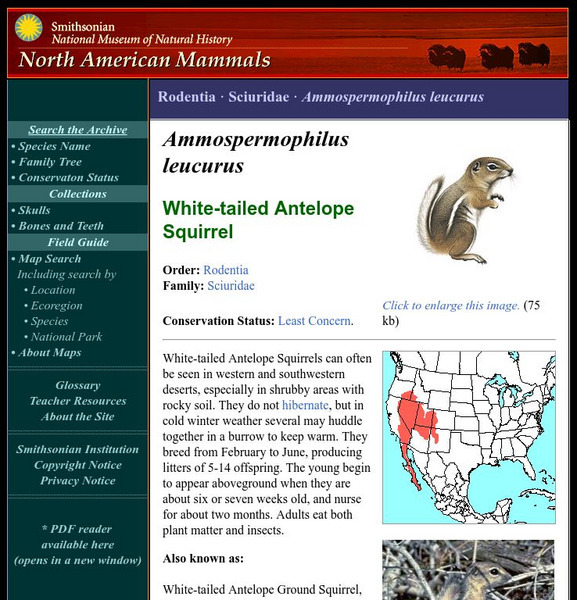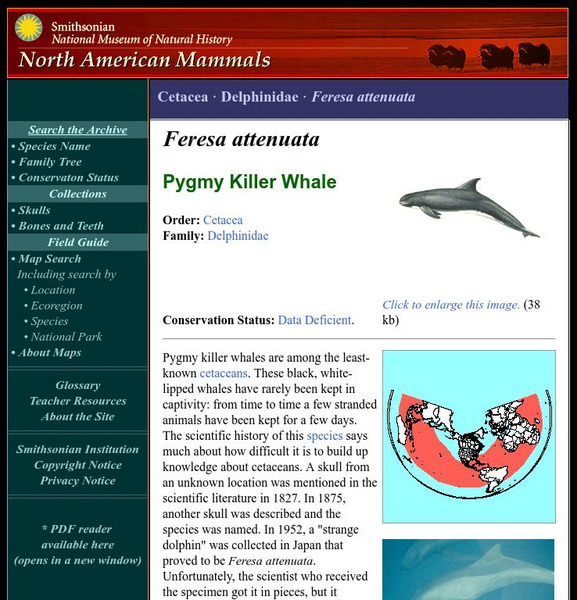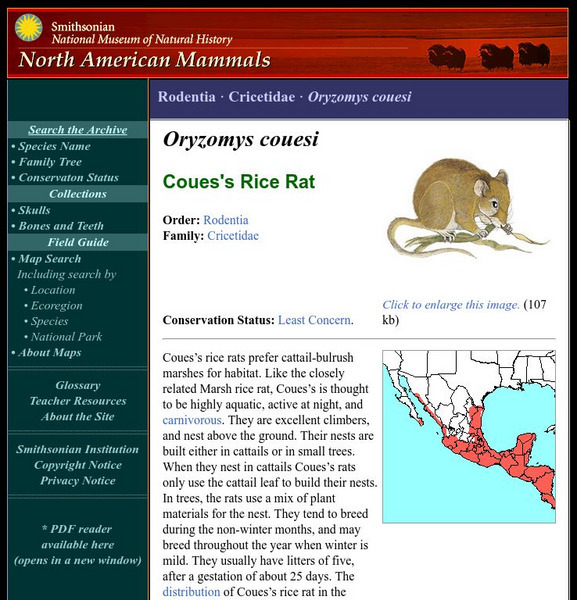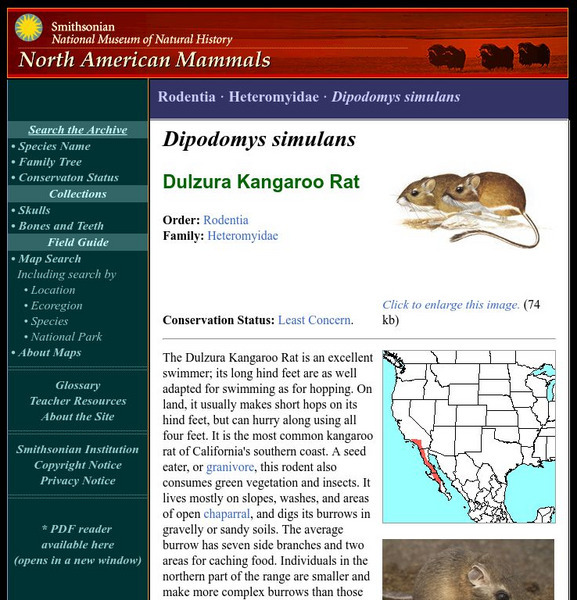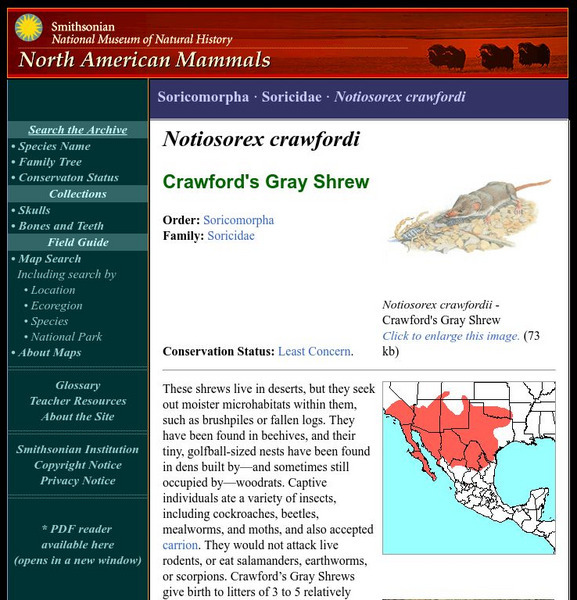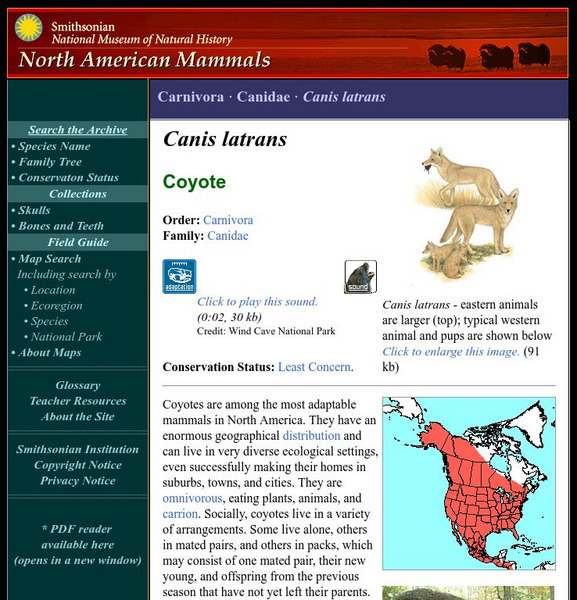Smithsonian Institution
National Museum of Natural History: American Mammals: White Tailed Antelope Squirrel
White-tailed Antelope Squirrels can often be seen in western and southwestern deserts, especially in shrubby areas with rocky soil. They do not hibernate, but in cold winter weather, several may huddle together in a burrow to keep warm....
Smithsonian Institution
National Museum of Natural History: American Mammals: Red Squirrel
Red Squirrels are very vocal. They bark at intruders, including humans, and can bark continuously for more than an hour if they are annoyed. Learn more about the Tamiasciurus hudsonicus, more commonly known as a Red Squirrel, in this...
Smithsonian Institution
National Museum of Natural History: American Mammals: Wyoming Pocket Gopher
Wyoming Pocket Gophers are known only from a small area in south-central Wyoming. These rather small Pocket Gophers seem to prefer loose, gravelly, upland soils, often where greasewood is growing. Learn more about the Thomomys clusius,...
Smithsonian Institution
National Museum of Natural History: American Mammals: West Indian Manatee
West Indian manatees are big, slow-moving, gentle vegetarians. They live in warm, shallow water in coastal rivers, estuaries, and lagoons. Learn more about the Trichechus manatus, more commonly known as a West Indian Manatee, in this...
Smithsonian Institution
National Museum of Natural History: American Mammals: Polar Bear
Polar Bears prey mostly on Ringed Seals. In the spring, the pups are easy prey. Learn more about the Ursus maritimus, more commonly known as a Polar Bear, in this easy-to-read species overview by the Smithsonian's National Museum of...
Smithsonian Institution
National Museum of Natural History: American Mammals: Red Fox
Red foxes are the most widely distributed wild carnivores in the world, occurring in North America, Asia, Europe, and North Africa. They are also widespread in Australia, where they were introduced in about 1850 so that fox-hunters would...
Smithsonian Institution
National Museum of Natural History: American Mammals: Meadow Jumping Mouse
Meadow Jumping Mice have very long tails and very large feet. They are most common in grassy or weedy fields, where they use runways made by other rodents. Learn more about the Zapus hudsonius, more commonly known as a Meadow Jumping...
Smithsonian Institution
National Museum of Natural History: American Mammals: Western Jumping Mouse
Western Jumping Mice are common in meadows, streamsides, and marshes in northwestern mountains. They also occur in subalpine meadows, and are found at low densities in dry, low-elevation, grassy habitats. Learn more about the Zapus...
Smithsonian Institution
National Museum of Natural History: American Mammals: Pacific Jumping Mouse
Pacific Jumping Mice are remarkably quick and unpredictable. They push off with both hind feet and land on both forefeet, apparently using the tail for balance--a Mouse who had lost its tail somersaulted trying to land. Learn more about...
Smithsonian Institution
National Museum of Natural History: American Mammals: Northern Red Backed Vole
The Northern Red-backed Vole lives in dry tundra and northern boreal forests (taiga). Two distinct coat coloration patterns exist within the species, one darkly colored, and a paler version. Learn more about the Clethrionomys rutilus,...
Smithsonian Institution
National Museum of Natural History: American Mammals: Western Red Backed Vole
The Western Red-backed Vole lives in conifer forests from the Columbia River south through western Oregon to northern California. Its population densities are greatest in dense, dark forests where there is little or no understory. Learn...
Smithsonian Institution
National Museum of Natural History: American Mammals: Nine Banded Armadillo
The tank-like Nine-banded Armadillo's range has greatly expanded northward in the last 100 years. In the mid-1800s it was found only as far north as southern Texas; by the 1970s it lived in Oklahoma, Kansas, Missouri, and Tennessee; now...
Smithsonian Institution
National Museum of Natural History: American Mammals: Northern Collared Lemming
Northern Collared Lemmings live farther north than any other rodent, making their homes on the Arctic tundra. They are among the few North American mammals to turn completely white in winter. Learn more about the Dicrostonyx...
Smithsonian Institution
National Museum of Natural History: American Mammals: Narrow Faced Kangaroo Rat
The Narrow-faced Kangaroo Rat, also known as the Santa Cruz Kangaroo Rat, occurs in central coastal California where annual rainfall is 75 cm and temperatures are moderate. It requires well-drained, deep soils and is often found on...
Smithsonian Institution
National Museum of Natural History: American Mammals: North Atlantic Right Whale
Northern right whales were hunted for at least 800 years until they became so rare that it was no longer commercially viable to hunt them. Biology made them and southern right whales the "right" whales to hunt, especially when whaling...
Smithsonian Institution
National Museum of Natural History: American Mammals: Pygmy Killer Whale
Pygmy killer whales are among the least-known cetaceans. These black, white-lipped whales have rarely been kept in captivity: from time to time a few stranded animals have been kept for a few days. Learn more about the Feresa attenuata,...
Smithsonian Institution
National Museum of Natural History: American Mammals: Southeastern Pocket Gopher
Equipped for a subterranean life, the Southeastern Pocket Gopher's muscular front legs, thick-set front body, massive claws on its front feet, small eyes and ears, and incisors protruding beyond the lips are obvious adaptations to life...
Smithsonian Institution
National Museum of Natural History: American Mammals: Coues's Rice Rat
Coues's rice rats prefer cattail-bulrush marshes for habitat. Like the closely related Marsh rice rat, Coues is thought to be highly aquatic, active at night, and carnivorous. Learn more about the Oryzomys couesi, more commonly known as...
Smithsonian Institution
National Museum of Natural History: American Mammals: Eastern Fox Squirrel
Eastern Fox Squirrels have long, foxtail-like tails, which they flick when they are excited. They and Eastern Gray Squirrels are alike in many ways. Learn more about the Sciurus niger, more commonly known as an Eastern Fox Squirrel, in...
Smithsonian Institution
National Museum of Natural History: American Mammals: Douglas' Squirrel
Douglas's Squirrels are small, energetic, and very active during the day all year long. They spend many hours collecting and storing green pine cones to eat during the harsh winters. Learn more about the Tamiasciurus douglasii, more...
Smithsonian Institution
National Museum of Natural History: American Mammals: Dulzura Kangaroo Rat
The Dulzura Kangaroo Rat is an excellent swimmer; its long hind feet are as well adapted for swimming as for hopping. On land, it usually makes short hops on its hind feet, but can hurry along using all four feet. Learn more about the...
Smithsonian Institution
National Museum of Natural History: American Mammals: Hispid Cotton Rat
The Hispid Cotton Rat's fur is sprinkled or streaked with blackish or dark brownish and grayish hairs. The Rats molt, losing and getting a new coat, three times in three months as they move through juvenile and subadult stages and into...
Smithsonian Institution
National Museum of Natural History: American Mammals: Crawford's Gray Shrew
These shrews live in deserts, but they seek out moister microhabitats within them, such as brush piles or fallen logs. They have been found in beehives, and their tiny, golfball-sized nests have been found in dens built by and sometimes...
Smithsonian Institution
National Museum of Natural History: American Mammals: Coyote
Coyotes are among the most adaptable mammals in North America. They have an enormous geographical distribution and can live in very diverse ecological settings, even successfully making their homes in suburbs, towns, and cities. Learn...
